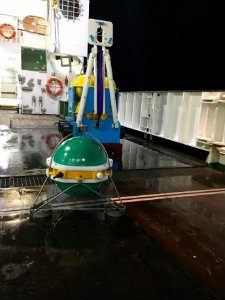 France has a rich history of working in the oceans, collecting some of the longest tidal records available, for example. During our voyage, we happened to pass the French research ship the “Pourquoi Pas?” off the west coast of Africa. The Institut de Physique du Globe in Paris (IPGP) runs geophysical observatories that monitor earthquake and volcanic activity both on land and in the oceans. Their OBS group – led by Wayne Crawford – is a National Equipment Facility. They have provided 9 instruments for the PiLAB experiment. IPGP has been a key player in broadband ocean bottom seismology, providing some of the earliest broadband instruments in an experiment led by Jean-Paul Montagner at 23oN on the Mid-Atlantic Ridge in 1992.
France has a rich history of working in the oceans, collecting some of the longest tidal records available, for example. During our voyage, we happened to pass the French research ship the “Pourquoi Pas?” off the west coast of Africa. The Institut de Physique du Globe in Paris (IPGP) runs geophysical observatories that monitor earthquake and volcanic activity both on land and in the oceans. Their OBS group – led by Wayne Crawford – is a National Equipment Facility. They have provided 9 instruments for the PiLAB experiment. IPGP has been a key player in broadband ocean bottom seismology, providing some of the earliest broadband instruments in an experiment led by Jean-Paul Montagner at 23oN on the Mid-Atlantic Ridge in 1992.
The IPGP sismomètre fond de mer (OBS) is based on the design developed by Scripps. Their instruments use a Nanometrics Trillium 240 broadband sensor. Below (left) is the sensor without its protective sphere, and to the right is one of the electronics busses, which include the CPU, the internal clock and hard-disk. Bristol owns 6 similar instruments for land stations. In comparison to the Compact in the LDEO instrument, the ‘240’ consumes more energy and has a slightly higher profile, which means that it is more sensitive to noise caused by ocean currents. But, these instruments are much more sensitive at longer periods. There are three primary uses for the long period signals that the 240s record: (1) surface wave studies, (2) ambient noise interferometry, (3) seafloor compliance measurements.
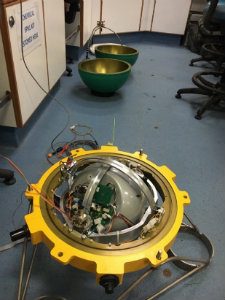
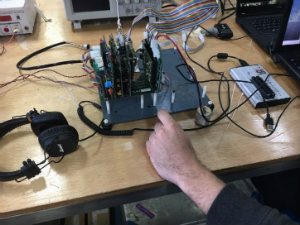
Seafloor compliance is still a relatively new way of measuring the shear modulus structure of the oceanic crust. It is particularly sensitive to variations in porosity in the shallow crust and the presence of melt in the deeper crust. The technique was first developed in the 1980’s by Japanese scientists, and in the early 1990’s Wayne and colleagues adapted the method to the deep ocean. The signal comes from very long period gravity waves that travel across the oceans. The amplitude of these waves is only a few millimetres and the results seafloor deformation is a few micrometres. Such studies are particularly useful near seafloor spreading centres, where melt and hydrothermal fluids control the generation of new oceanic crust.
 Surface waves are the longer period seismic phases that propagate along the surface of the Earth and decay in strength exponentially with depth. They are particularly good at resolving variations with depth in the velocity structure of the outermost few 100s of kilometres of the Earth. To the right is a seismogram of a large earthquake in Chile, recorded on one of the IPGP instruments nearly 8000km away. The first obvious signal is the P-wave arrival, followed by S-wave signals. The large and long duration signal at the end of the seismogram is the packet of surface wave energy.
Surface waves are the longer period seismic phases that propagate along the surface of the Earth and decay in strength exponentially with depth. They are particularly good at resolving variations with depth in the velocity structure of the outermost few 100s of kilometres of the Earth. To the right is a seismogram of a large earthquake in Chile, recorded on one of the IPGP instruments nearly 8000km away. The first obvious signal is the P-wave arrival, followed by S-wave signals. The large and long duration signal at the end of the seismogram is the packet of surface wave energy.
Seismology has seen a bit of a revolution in the past decade in the use of seismic noise as a signal to image the Earth. Rather than fighting to get rid of noise, this technique embraces it, looking at the correlation between noise at stations to infer the seismic signal between stations. In its simplest application, so-called ambient noise tomography inverts the correlated noise structure for Earth structure, using techniques similar to those used in the analysis of surface waves.
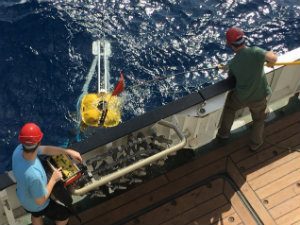
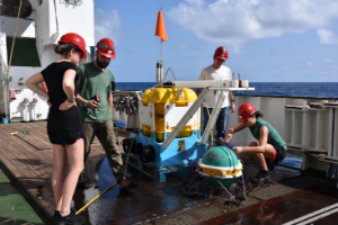
Above is an IPGP OBS as it comes aboard and the entire IPGP team, Wayne (scientists and facility director), Simone (technical engineer), Océane (PhD student) and Michaela (Masters student). Their instruments can be deployed for up to 13 months and at depths up to 5000m. Flotation comes from 8 flotation spheres, 33cm in diameter, and they rise at a rate of roughly 31m/min, which means that it takes a little over 2 hours to rise from a depth of 4000m. The anchor is a large metal grate that attaches to the bottom of the instrument. They are next being used in the Mediterranean as part of a large European experiment focused on the Alps.